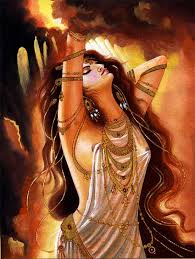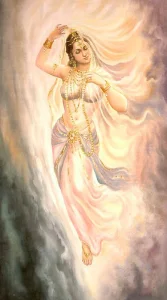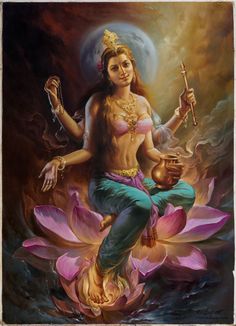Who are Yakshinis or Yakshis in Hindu Tantra Yoga? How are they different from other supernatural beings?
In Hindu Tantra Yoga, Yakshinis or Yakshis are supernatural beings that are believed to have originated from the Himalayan region. They are often depicted as female entities with great beauty and power. While they are similar to other supernatural beings such as devas, asuras, and rakshasas, there are distinct differences that set them apart.
Table of Contents
Who are Yakshinis or Yakshis in Hindu Tantra Yoga?
In Tantra, Yakshinis are often prayed as part of various rituals and practices designed to help practitioners achieve spiritual enlightenment or other desired outcomes. For example, practitioners may invoke a specific Yakshini to help them with a particular goal, such as attracting wealth or finding a romantic partner.








While Yakshinis are similar to other supernatural beings in Hindu mythology, such as Devas, Asuras, and Rakshasas, they are also distinct in a number of ways. For one thing, Yakshinis are often associated with specific natural elements, such as water, air, or trees, while other supernatural beings are not necessarily tied to any particular element.
Relationship of Yaksha and Yakshinis


In Hinduism, Yakshas and Yakshinis are often depicted as complementary beings, with the Yakshas being male spirits or deities and the Yakshinis being their female counterparts. Yakshas are sometimes described as nature spirits or protectors of natural resources, while Yakshinis are often associated with fertility, prosperity, and abundance.
In some traditions, Yakshas and Yakshinis are believed to be the children of the God Brahma and are said to inhabit the natural world, including forests, lakes, and mountains. They are sometimes depicted as mischievous beings, but can also be benevolent and helpful to humans who show them respect and devotion.
There are many myths and stories about the relationships between Yakshas and Yakshinis, often involving themes of love, devotion, and loyalty. In some traditions, it is believed that Yakshas and Yakshinis must be worshipped together in order to receive their blessings and protection.
How to Pray Yakshinis – Yakshini Sadhana
Praying to Yakshinis or Yakshis can be a deeply personal and spiritual experience. It is important to approach the practice with reverence, respect, and a pure heart. Pray to Yakshinis varies with the vidya given to you by your Guru. Follow the instructions from your Guru. General instructions or general guidelines for how to pray to Yakshinis:
- Find a quiet and peaceful space where you will not be disturbed. It can be helpful to create an altar or sacred space specifically for your Yakshini prayers.
- Begin by cleansing your space and yourself. This can be done through a variety of methods, such as smudging with sage or incense, taking a purifying bath or shower, or reciting a prayer or mantra for cleansing.
- Light a candle or incense as an offering to the Yakshini you wish to connect with. You can also offer flowers, fruit, or other items that are meaningful to you and the Yakshini.
- Take a few deep breaths and center yourself. Clear your mind and focus your intention on connecting with the Yakshini.
- Invoke the Yakshini by reciting her mantra or name. You can also visualize her form or image in your mind’s eye.
- Offer your prayers, requests, and intentions to the Yakshini. Be sincere and honest in your communication, and trust that the Yakshini will hear your prayers and respond in her own way.
- Listen for any messages or insights that may come through during your prayer. You may also feel a sense of peace, comfort, or guidance from the Yakshini.
- Thank the Yakshini for her presence and blessings. You can also offer a final offering, such as a final prayer or an offering of gratitude.
Remember that prayer to Yakshinis is a personal practice and may vary from person to person. It is important to approach the practice with an open heart and mind and to trust in the wisdom and guidance of the Yakshini.
Has Anyone Seen Yakshinis
Belief in Yakshinis and other supernatural beings is common in Hinduism and other traditions in South Asia. There are many stories and myths about Yakshinis and encounters with them, Most of these are secret practices and teachings from Guru.
In popular culture and folklore, Yakshinis are often depicted as beautiful women with magical powers, but it is unclear whether anyone has actually seen a Yakshini in a physical form but many spiritual beings have felt their presence.
It is important to note that belief in supernatural beings is a matter of faith and personal experience, and individuals may have different interpretations and beliefs about Yakshinis based on their cultural and religious backgrounds.
Are Yakshinis Dangerous?
In Hinduism, India, and other traditions in South Asia, Yakshinis are generally not considered to be dangerous or malevolent beings. Rather, they are often seen as benevolent spirits or deities associated with fertility, prosperity, and abundance.
However, as with any spiritual or supernatural being, there are stories and myths that depict Yakshinis as potentially dangerous or powerful beings. In some traditions, Yakshinis are said to be able to cause illness, misfortune, or other difficulties for those who displease them or fail to show them proper respect.
It is important to note, however, that these stories are often cultural or religious myths, the wisdom comes from rigorous spiritual practice. As with any belief or tradition, it is important to approach the idea with an open mind and respect for the beliefs and traditions of others.
How Yakshinis are different from other supernatural beings?
Role of Yakshinis
One of the most significant differences between Yakshinis and other supernatural beings is their role in Hindu mythology. While devas and asuras are often seen as gods and demons respectively, Yakshinis are neither good nor evil. Instead, they are viewed as neutral entities that can be benevolent or malevolent depending on how they are approached.
Association With Wealth and Prosperity
Another key difference is their association with wealth and prosperity. Yakshinis are often depicted as guardians of hidden treasure and secret knowledge. They are believed to have the power to grant wealth and prosperity to those who appease them. As a result, they are often invoked during rituals and offerings in order to gain their favor.
Appearance of Yakshinis
In terms of appearance, Yakshinis are often depicted as beautiful women with a variety of adornments such as jewelry, flowers, and various garments. They are also sometimes depicted as having animalistic features such as wings or tails. Despite their physical beauty, they are not to be underestimated, as they are believed to possess great power and knowledge.
Association of Yakshinis
Yakshinis are often associated with specific mantras, yantras, and rituals that are used to invoke their presence. These practices are said to be powerful tools for gaining their favor and accessing their wisdom and power. It is important to note, however, that approaching Yakshinis should be done with respect and caution, as their power can be unpredictable and dangerous if not handled properly.
What are the supernatural powers of Yakshinis?
In Hindu Tantra, Yakshinis are believed to possess various supernatural powers. Some of the commonly attributed powers of Yakshinis are:
- Material Wealth: Yakshinis are believed to be associated with wealth and prosperity. Worshiping them is said to attract material riches and abundance.
- Supernatural Strength: Yakshinis are considered to be extremely powerful beings with immense physical strength. They are believed to be able to lift heavy objects effortlessly and perform other physical feats that are beyond human capabilities.
- Psychic Abilities: Yakshinis are believed to have psychic powers such as clairvoyance, telepathy, and precognition. It is said that they can communicate with humans through dreams and visions.
- Healing: Yakshinis are known for their healing powers. It is believed that they can cure diseases and ailments by transferring their energy to the afflicted person.
- Protection: Yakshinis are considered to be powerful protectors against evil spirits and negative energies. It is believed that invoking their name can ward off any harm or danger.
- Beauty and Charm: Yakshinis are often depicted as beautiful and alluring beings. It is believed that they possess the power to enhance a person’s physical attractiveness and charm.
- Knowledge and Wisdom: Yakshinis are said to possess vast knowledge and wisdom. Worshiping them is believed to bestow knowledge, wisdom, and intelligence to the devotee.
Yakshinis are revered as divine beings with various supernatural abilities. It is believed that by worshiping them, one can gain their blessings and tap into their powers for personal gain and spiritual growth.
Relation Between Yakshinis and Yoginis
Yakshinis and Yoginis are both supernatural beings in Hindu Tantra Yoga, but they have some key differences.
Yakshinis are female beings are believed to be guardians of hidden treasures and are associated with the earth and the underworld. They are often worshipped for their ability to bestow wealth and abundance upon those who offer them devotion and offerings.

Yoginis, on the other hand, are female deities associated with yoga and meditation. They are often depicted as fierce, powerful, and independent women who have attained enlightenment through their practice of yoga. Yoginis are believed to possess supernatural powers and are often worshipped for their ability to grant spiritual insight and wisdom.
symbolism and attributes
In terms of their symbolism and attributes, Yakshinis are associated with the material world and the pursuit of worldly desires, while Yoginis are associated with the spiritual world and the pursuit of spiritual enlightenment. While Yakshinis are often depicted as alluring and seductive, Yoginis are portrayed as powerful and independent, reflecting the qualities of a successful yogi.
worship and practice
In terms of their worship and practice, Yakshinis are often propitiated through offerings and rituals that are focused on obtaining wealth and abundance, while Yoginis are worshipped through meditation and yoga practices that are aimed at achieving spiritual insight and awakening.
Both Yakshinis and Yoginis are powerful supernatural beings in Hindu Tantra Yoga, they represent different aspects of the spiritual path, with Yakshinis representing the pursuit of worldly desires and Yoginis representing the pursuit of spiritual enlightenment.
Who is the God of Yakshinis
In Hinduism, there is no single god or goddess who is considered the god of all Yakshinis. Yakshinis are a type of female spirit or deity, often associated with nature, fertility, and abundance.

Different Yakshinis may be associated with different aspects of nature, such as trees, lakes, or mountains, and each may have her own unique attributes and powers. Some Yakshinis are associated with specific Hindu gods or goddesses and are believed to serve and protect them.
In Hindu traditions, the Yakshinis are said to be attendants of Kubera, the god of wealth, and are believed to bestow wealth and abundance on those who please them. However, there is no single god or goddess who is considered the god of all Yakshinis in Hinduism.
Conclusion
In conclusion, Yakshinis are fascinating entities in Hindu mythology that are associated with wealth, prosperity, and hidden knowledge. While they share some similarities with other supernatural beings, their neutral nature and unique qualities set them apart. Approaching Yakshinis requires respect and caution, but for those who are able to connect with them, their power and wisdom can be valuable assets on the path to enlightenment.
Reference
- A History of Ancient and Early Medieval India: From the Stone Age to the 12th Century by Upinder Singh, Pearson Education India, 2008 [1]
- Bhairav, J. Furcifer; Khanna, Rakesh (2021). Ghosts, Monsters, and Demons of India. India: Blaft Publications Pvt. Ltd. pp. 418–421. ISBN 9789380636474.
- “Yaksha | Hindu mythology” by .
- Magee, Mike (2006). “Yakshinis and Chetakas”. Shiva Shakti Mandalam. Archived from the original on 18 March 2009. Retrieved 2 March 2016.
- ^ Krishnan, Murali (2020). “Supreme Court upholds royals’ rights on Sri Padmanabhaswamy temple”. Hindustan Times.
- Misra, Ram Nath (1981). Yaksha Cult and Iconography (PDF). Munshiram Manoharlal.
- ^ Vasanthan, Aruna. “Jina Sasana Devatas”. Tamil Jain. Archived from the original on 27 October 2009. Retrieved 2 March 2016.
